It looks like you're using an Ad Blocker.
Please white-list or disable AboveTopSecret.com in your ad-blocking tool.
Thank you.
Some features of ATS will be disabled while you continue to use an ad-blocker.
share:
Just wondering if you swiped this story from Coast to Coast AM ? Seems most stories here are sourced by other sites main stories
a reply to: Silcone Synapse
If nothing else it shows those of us who imagine we know what is possible or likely in a given situation, can be so easily and utterly wrong, about anything we take for granted.
This also adds credibility (i suspect to the chagrin of those who are convinced otherwise), to the tales and reports of certain other life forms, based essentially on what appears to be pure energy forms.
This bacteria is at least a tiny crack into the window of possibility, that higher, more evolved forms of life also survive and thrives on pure energy to sustain them.
And to take it a step further, a life form of that sort would partner perfectly with nano-machines and could quite possibly become solid, ethereal - wisp like, or seem to become invisible at will, as well as arranging the nanobots into virtually any body form they chose to be, from an 'angel', to a bigfoot, to a common cat or dog...or any Human being.
Remember the reports of glowing ET's that could pass through solid walls..a life form based on pure energy could do this.
If nothing else it shows those of us who imagine we know what is possible or likely in a given situation, can be so easily and utterly wrong, about anything we take for granted.
This also adds credibility (i suspect to the chagrin of those who are convinced otherwise), to the tales and reports of certain other life forms, based essentially on what appears to be pure energy forms.
This bacteria is at least a tiny crack into the window of possibility, that higher, more evolved forms of life also survive and thrives on pure energy to sustain them.
And to take it a step further, a life form of that sort would partner perfectly with nano-machines and could quite possibly become solid, ethereal - wisp like, or seem to become invisible at will, as well as arranging the nanobots into virtually any body form they chose to be, from an 'angel', to a bigfoot, to a common cat or dog...or any Human being.
Remember the reports of glowing ET's that could pass through solid walls..a life form based on pure energy could do this.
a reply to: Silcone Synapse
Pretty amazing. I just can't fathom any stronger evidence than things like this to prove that this universe is a big program, really not much different than our software programs, just on an almost infinitely complex scale. The same reason our heart beats without ever thinking about it
Pretty amazing. I just can't fathom any stronger evidence than things like this to prove that this universe is a big program, really not much different than our software programs, just on an almost infinitely complex scale. The same reason our heart beats without ever thinking about it
I think the article is an exaggeration to say, they consume nothing but electrons.
It stands to reason - that if they have a material body that consists of protein (amongst other matter), then that matter must come from somewhere and be 'consumed'.
It stands to reason - that if they have a material body that consists of protein (amongst other matter), then that matter must come from somewhere and be 'consumed'.
originally posted by: spacemanjupiter
a reply to: Silcone Synapse
Pretty amazing. I just can't fathom any stronger evidence than things like this to prove that this universe is a big program, really not much different than our software programs, just on an almost infinitely complex scale. The same reason our heart beats without ever thinking about it
We have software programs that eat individual electrons?
I remember reading something about some sort of bacteria found in nuclear plants that lived off nuclear fuel.
This could be the solution to multiplying mass amounts of energy. Possibly free energy or a multiplying power station. The byproduct is electrons and even that's beneficial. IDK....when it sounds too good to be true....
This could be the solution to multiplying mass amounts of energy. Possibly free energy or a multiplying power station. The byproduct is electrons and even that's beneficial. IDK....when it sounds too good to be true....
originally posted by: Barcs
originally posted by: spacemanjupiter
a reply to: Silcone Synapse
Pretty amazing. I just can't fathom any stronger evidence than things like this to prove that this universe is a big program, really not much different than our software programs, just on an almost infinitely complex scale. The same reason our heart beats without ever thinking about it
We have software programs that eat individual electrons?
You forgot the "and poops them out" part.
This is exactly like saying that a rechargeable battery "eats" electrons when being charged and "excretes" electrons when being used. Yeah,
right...
They are actually talking about a redox reaction, where an atom or molecule can gain or lose an electron.
This bacterium can use redox reactions involving iron in some of it's metabolic pathways. It still needs to get all the other organic molecules and atoms (carbon, nitrogen, phosphorus etc) from other sources.
IF it only needed electrons and was some kind of "electric" entity, they why does the OP video show it reaching for gunk as food?
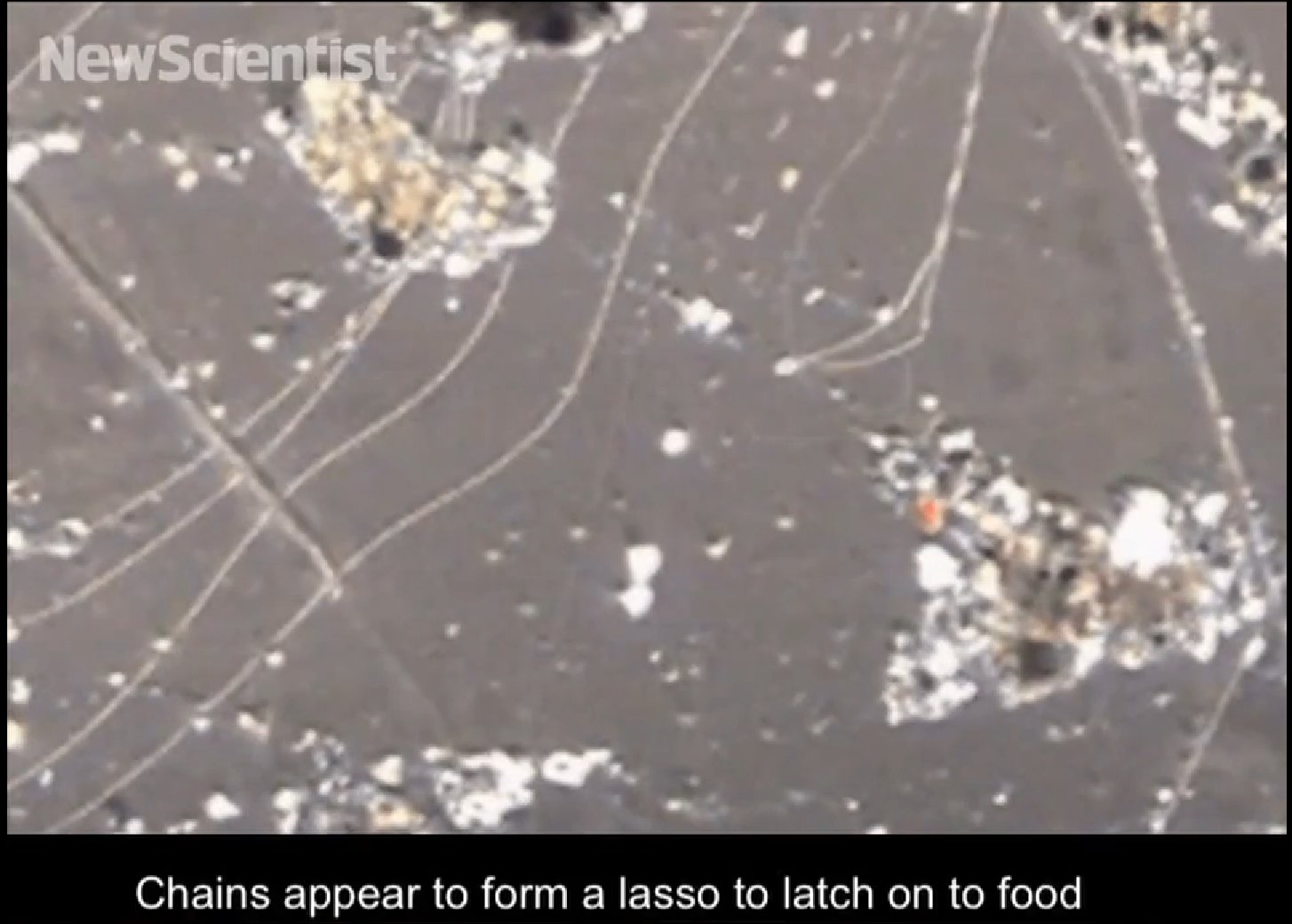
The article is very misleading. They use this picture:
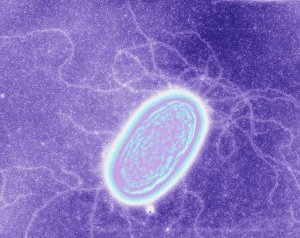
This was actually done by an artist. He took an image of the bacterium and colorized it, to make it look spacey.
Link
This is what a normal photograph would look like:
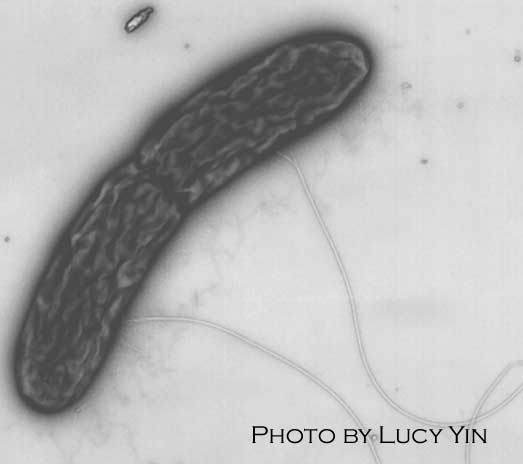
Link
It is amazing that it can move electrons around like this, but I think they're stretching the truth a bit. Deny Ignorance and all that.
They are actually talking about a redox reaction, where an atom or molecule can gain or lose an electron.
This bacterium can use redox reactions involving iron in some of it's metabolic pathways. It still needs to get all the other organic molecules and atoms (carbon, nitrogen, phosphorus etc) from other sources.
IF it only needed electrons and was some kind of "electric" entity, they why does the OP video show it reaching for gunk as food?

The article is very misleading. They use this picture:

This was actually done by an artist. He took an image of the bacterium and colorized it, to make it look spacey.
Link
This is what a normal photograph would look like:

Link
It is amazing that it can move electrons around like this, but I think they're stretching the truth a bit. Deny Ignorance and all that.
originally posted by: Silcone Synapse
This is one of the little rascals,named "geobacter metallireducens":
Anyone else thought of:
"Midi-chlorians - intelligent microscopic life forms that lived symbiotically inside the cells..."
This actually reminds me of a Metroid brain(NES game: Metroid) They were set up basically the same way. Very interesting.
originally posted by: ionwind
This is exactly like saying that a rechargeable battery "eats" electrons when being charged and "excretes" electrons when being used. Yeah, right...
They are actually talking about a redox reaction, where an atom or molecule can gain or lose an electron.
This bacterium can use redox reactions involving iron in some of it's metabolic pathways. It still needs to get all the other organic molecules and atoms (carbon, nitrogen, phosphorus etc) from other sources.
IF it only needed electrons and was some kind of "electric" entity, they why does the OP video show it reaching for gunk as food?
The article is very misleading. They use this picture:
This was actually done by an artist. He took an image of the bacterium and colorized it, to make it look spacey.
Link
This is what a normal photograph would look like:
Link
It is amazing that it can move electrons around like this, but I think they're stretching the truth a bit. Deny Ignorance and all that.
Interesting response. What in your opinion is the potential in relation to the issue of all, " According to endosymbiosis theory, do all mitochondria in human cells originate from 1 type of aerobic bacteria?
All the mitochondria in human cells are identical and by normal evolutionary thinking came from a single ancestor. For there to be two types you would have to suppose that some single-celled ancestor formed a partnership with two or more kinds of bacteria that became symbiotes and that both kind of mitochondria were retained in all the intermediate species leading to humans. Or you would have to assume sequential endosymbiotic partnerships forming several times which seems equally unlikely.
This does not mean that all mitochondria in all species came from a single ancestor bacteria. There is some evidence that different lines of protists may have independent lineages of mitochondria. We definitely know that there are several lines of photosynthetic endosymbiotes which is why these are now described collectively as plastids rather than chloroplasts which are the line found in plants.
As to the name of the bacteria, remember that hundreds of millions of years of evolution separate that original endosymbiont from modern bacteria. There is some evidence that it was related to modern alpha-proteobacteria but trying to identify a species is impossible. The article is rather technical but you can read more about the linkage to alpha-proteobacteria here www.ncbi.nlm.nih.gov...
Source:
I teach biology.
answers.yahoo.com...
Is it possible for this type of bacteria, upon some other Earth like planet, to become the primary "blueprint", for intelligent life??
What potentially in your opinion would be the consequence???
Any thoughts?
originally posted by: Kashai
Interesting response. What in your opinion is the potential in relation to the issue of all, " According to endosymbiosis theory, do all mitochondria in human cells originate from 1 type of aerobic bacteria?
Any thoughts?
Cells like Geobacter metallireducens use metals like iron (Fe) for electron exchange in their metabolism, e.g.:
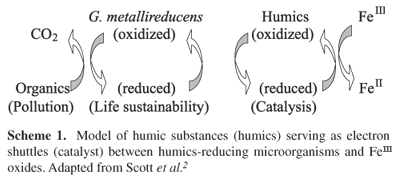
Link
Mitochondria are generally thought to be bacteria that were incorporated into eukaryotes (cells with a nucleus) forming a symbiotic relationship. Currently they think this may have happened around 2 billion years ago.
A simple example would be that a eukaryote, like an amoeba, ingested a mitochondria but instead of digesting it, kept it around since it was producing energy for the amoeba.
Mitochondria generate a molecule called ATP which provides energy for the whole cell. In the mitochondria, there are no metals like iron (Fe) involved in creating ATP, e.g. Oxidative phosphorylation:
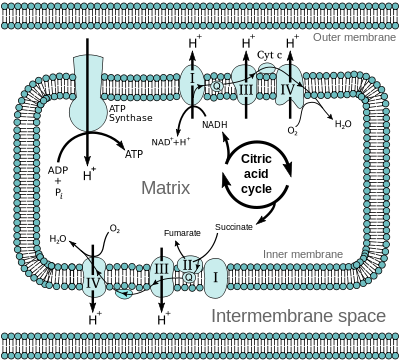
Wiki
So, the bacterium in the OP is not a good candidate for what happened 2 billion years ago.
Your question also make me think about what NASA calls a "Second Genesis" or "Shadow Biosphere". This hypothesis says that life may have evolved more than once on Earth. One example they give is the discovery of an extremophile that uses arsenic instead of phosphorus in its DNA. If you believe in Panspermia, Earth may have been seeded more than once by different microbes.
Link
a reply to: Silcone Synapse
A lasso huh? Thats how we getting to the moon next time
A joking aside.
Very intresting news.
A lasso huh? Thats how we getting to the moon next time
A joking aside.
Very intresting news.
new topics
-
Fired fema employee speaks.
US Political Madness: 36 minutes ago -
How long till it starts
US Political Madness: 1 hours ago -
USSS Agent Fired for Having Sex In Michelle Obama's Bathroom
US Political Madness: 3 hours ago -
Watching TV
Jokes, Puns, & Pranks: 6 hours ago
top topics
-
RFK is Trumps health pick
2024 Elections: 14 hours ago, 20 flags -
USSS Agent Fired for Having Sex In Michelle Obama's Bathroom
US Political Madness: 3 hours ago, 7 flags -
How long till it starts
US Political Madness: 1 hours ago, 7 flags -
Watching TV
Jokes, Puns, & Pranks: 6 hours ago, 6 flags -
Fired fema employee speaks.
US Political Madness: 36 minutes ago, 5 flags
active topics
-
The art of being offended
Social Issues and Civil Unrest • 42 • : Astrocometus -
The Trump effect 6 days after 2024 election
2024 Elections • 118 • : PorkChop96 -
USSS Agent Fired for Having Sex In Michelle Obama's Bathroom
US Political Madness • 20 • : WeMustCare -
The Reactionary Conspiracy 13. The plot’s theology.
General Conspiracies • 298 • : Oldcarpy2 -
Fired fema employee speaks.
US Political Madness • 3 • : DAVID64 -
FLORIDA Sues Biden-Harris FEMA for Denying Disaster Assistance to Homeowners with TRUMP Signs.
US Political Madness • 50 • : some_stupid_name -
Survey: Over Half of Kamala Harris Voters Want to Relocate After Donald Trump’s Election Victory
US Political Madness • 64 • : mysterioustranger -
RFK is Trumps health pick
2024 Elections • 9 • : nugget1 -
WATCH LIVE: US Congress hearing on UFOs, unidentified anomalous phenomena
Aliens and UFOs • 70 • : Lazy88 -
President-Elect DONALD TRUMP's 2nd-Term Administration Takes Shape.
Political Ideology • 194 • : matafuchs

